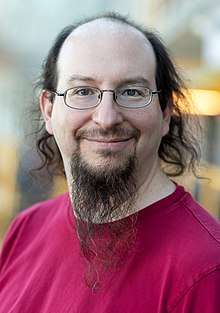Ian Goldberg
Ian Avrum Goldberg (born March 31, 1973) is a cryptographer and cypherpunk. He is best known for breaking Netscape's implementation of SSL (with David Wagner),[1] and for his role as chief scientist of Radialpoint (formerly Zero Knowledge Systems), a Canadian software company. Goldberg is currently a professor at the David R. Cheriton School of Computer Science, within the University of Waterloo. He was formerly Tor Project board of directors chairman,[2] and is one of the designers of off the record messaging.[3]
Ian Avrum Goldberg | |
|---|---|
 | |
| Born | March 31, 1973 |
| Alma mater |
|
| Known for | Off-the-Record Messaging |
| Scientific career | |
| Fields | Computer Science |
| Institutions | University of Waterloo |
| Thesis | "A Pseudonymous Communications Infrastructure for the Internet" (2000) |
| Doctoral advisor | Eric Brewer |
| Website | www |
Education
He attended high school at the University of Toronto Schools, graduating in 1991. In 1995, he received a B.Math from the University of Waterloo in pure mathematics and computer science. He obtained a Ph.D. from the University of California, Berkeley in December 2000. His thesis was entitled A Pseudonymous Communications Infrastructure for the Internet.[4] His advisor was Eric Brewer.
Accomplishments
As a high school student, Goldberg was a member of Canada's team to the International Math Olympiad from 1989 to 1991, where he received a bronze, silver, and gold medal respectively.[5] He was also a member of University of Waterloo team that won the ACM International Collegiate Programming Contest in 1994.[6] In 1998, Wired Magazine chose him as a member of the "Wired 25".[7] In 2011 he won the EFF Pioneer Award.[8]
Work in cryptography
In 1995, Goldberg with David Wagner discovered a flaw in the random number generator used for temporary key generation in the SSL implementation of Netscape Navigator.[1][9]
One of the first cryptanalyses on the WEP wireless encryption protocol was conducted by Goldberg with Nikita Borisov and David Wagner, revealing serious flaws in its design.[10][11]
Goldberg was a co-author of the Off-the-Record instant messaging encryption protocol. He is also the author of the Perl script included in the novel Cryptonomicon by Neal Stephenson.[12]
In 2009 Goldberg was co-author of the Sphinx Mix Format [13] which is nowadays implemented with the extension of a per hop payload to increase the privacy of payer and payee while routing Bitcoin payments through the Lightning Network.[14]
See also
- Data privacy
- Information privacy
Notes and references
- Ian Goldberg (1995-09-18). "Netscape SSL implementation cracked!". Newsgroup: hks.lists.cypherpunks. Retrieved 2006-09-12.
- "Tor Project, a Digital Privacy Group, Reboots With New Board". Retrieved 2016-07-13.
- "Tor Project Board of Directors". Tor Project. Retrieved January 26, 2015.
- "Wayback Machine" (PDF). 30 October 2001.
- "International Mathematical Olympiad: Hall of fame".
- "1993-94 18th Annual ACM International Collegiate Programming Contest Final Report". 2002-04-01. Archived from the original on 2011-01-02.
- "The Wired 25". Wired. 6 (11). November 1998. Retrieved 2006-10-30.
- "EFF Celebrates the 2011 Pioneer Award Winners". Retrieved 10 December 2011.
- "The Cypherpunks Who Cracked Netscape". people.eecs.berkeley.edu.
-
Nikita Borisov; Ian Goldberg; David Wagner (2001). "Intercepting Mobile Communications: The Insecurity of 802.11" (PDF). Retrieved 2006-09-12. Cite journal requires
|journal=(help) - "(In)Security of the WEP algorithm". www.isaac.cs.berkeley.edu.
- Neal Stephenson (1999). Cryptonomicon. New York: Avon Books. p. Acknowledgements. ISBN 978-0-380-97346-0.
- "Sphinx: A Compact and Provably Secure Mix Format" (PDF). cypherpunks.ca/~iang/.
- "Basics Of Lightning Technology #4: Onion Routing Protocol". www.github.com/lightningnetwork/lightning-rfc.
External links
- Ian Goldberg's website at the University of California, Berkeley
- Ian Goldberg at the David R. Cheriton School of Computer Science
- Ian Goldberg's publications
- Experience With Top Gun Wingman: A Proxy-Based Graphical Web Browser for the 3Com PalmPilot
- Wingman: A web browser created for the Palm Pilot PDA
- http://daedalus.cs.berkeley.edu/